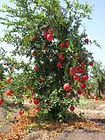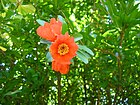Note: This is a project under development. The articles on this wiki are just being initiated and broadly incomplete. You can Help creating new pages.
Punica granatum - Dadima
Dadima, Pomegranate has been used for thousands of years to cure a wide range of diseases across different cultures and civilizations. It has great nutritional value and numerous health benefits.
Contents
- 1 Uses
- 2 Parts Used
- 3 Chemical Composition
- 4 Common names
- 5 Properties
- 6 Habit
- 7 Identification
- 8 List of Ayurvedic medicine in which the herb is used
- 9 Where to get the saplings
- 10 Mode of Propagation
- 11 How to plant/cultivate
- 12 Commonly seen growing in areas
- 13 Photo Gallery
- 14 References
- 15 External Links
Uses
Ulcers, Urinary infections, Skin disorders, Digestive disorders, Arthritis, Diarrhea, Bloating [1]
Parts Used
Chemical Composition
Pomegranate fruit arils contain huge amounts of organic acids, sugars, minerals, vitamins, and polyphenols that show antioxidant effect. Moreover, flavonoids are chief polyphenols of fruit, condensed tannins and hydrolysable tannins. Hydrolyzable tannins including ellagitannins and gallotannins consist of the common constituents present in pomegranate, and punicalagin is the major hydrolyzable tannin present in pomegranates. The juice of arils consist of water, sugars such as glucose, sucrose, and fructose, 1.5% pectin, organic acids including citric, malic, tartaric, succinic, fumaric and ascorbic acid. [2]
Common names
| Language | Common name |
|---|---|
| Kannada | daadima, daalimbe, dadimbe |
| Hindi | anar |
| Malayalam | dadimam, matalam, matalam-cheti, matalanarakam, urumampazham |
| Tamil | madalai-p-pazham, maathulai, maathulam |
| Telugu | daadimba, daalimba chettu, daalimma, daanimma, dadima |
| Marathi | NA |
| Gujarathi | NA |
| Punjabi | NA |
| Kashmiri | NA |
| Sanskrit | dadima, raktabija, raktapushpa, lohithapushpa |
| English | pomegranate |
Properties
Reference: Dravya - Substance, Rasa - Taste, Guna - Qualities, Veerya - Potency, Vipaka - Post-digesion effect, Karma - Pharmacological activity, Prabhava - Therepeutics.
Dravya
Rasa
Madhura (Sweet), Amla (Sour), Kashaya (Astringent)
Guna
Laghu (Light), Snigdha (Unctuous)
Veerya
Anushna (Neither hot nor cold)
Vipaka
Madhura (Sweet), Amla (Sour)
Karma
Vata, Pitta, Kapha
Prabhava
Habit
Identification
Leaf
| Kind | Shape | Feature |
|---|---|---|
| Simple | Opposite | Leaves glabrous, lustrous, 19-35(-50) x 8-12 (-15) mm, oblong-lanceolate to obovate or elliptic, subpetiolate, entire, apex sub-actue to obtuse. |
Flower
| Type | Size | Color and composition | Stamen | More information |
|---|---|---|---|---|
| Bisexual | axillary or terminal | Scarlet red | Many | Flowers scarlet red or white, conspicuous, 3 cm or more in length. Calyx 20-35 mm long, indented slightly above the middle, reddish, somewhat succulent; lobes 5-7,c. 8 mm long, triangular. Petals and stamens inserted at the throat of the calyx. Petals 16-20 x 10-12 mm, broadly obovate, wrinkled, alternating with the sepal lobes. Filaments c. 7 mm long, multiseriate, persistent. Ovary subglobose; style thick, c. 1 cm long, reddish; stigma simple; slightly bilobed. |
Fruit
| Type | Size | Mass | Appearance | Seeds | More information |
|---|---|---|---|---|---|
| A berry | 2-8 cm across | partitioned by thin leathery yellow septa; the rind thick and coriaceous. | Seeds red or pink, c. 10 mm long, angular, testa thick, fleshy and juicy | {{{6}}} |
Other features
List of Ayurvedic medicine in which the herb is used
Where to get the saplings
Mode of Propagation
How to plant/cultivate
Season to grow
Soil type
Propagation
Commonly seen growing in areas
Tropical area, Sub Tropical area, Desert area.
Photo Gallery
References
- ↑ https://www.ncbi.nlm.nih.gov/pubmed/21623786 "Uses"]
- ↑ Active Constituents of Pomegranates (Punica granatum) as Potential Candidates in the Management of Health through Modulation of Biological Activities, Arshad Husain Rahmani, Mohamed Ali Alsahli, Saleh Abdulrahman Almatroodi, PHCOG J, VOL 9, ISSUE 5, SEP-OCT, 2017 "Chemical Composition"]
- ↑ "Vernacular names"
- ↑ FLOWERING PLANTS OF KERALA VER.2, N.SASIDHARAN "BOTANIC DESCRIPTION"]
External Links
- Ayurvedic Herbs known to be helpful to treat Ulcers
- Ayurvedic Herbs known to be helpful to treat Urinary infections
- Ayurvedic Herbs known to be helpful to treat Skin disorders
- Ayurvedic Herbs known to be helpful to treat Digestive disorders
- Ayurvedic Herbs known to be helpful to treat Arthritis
- Ayurvedic Herbs known to be helpful to treat Diarrhea
- Ayurvedic Herbs known to be helpful to treat Bloating
- Herbs with Fruits used in medicine
- Herbs with Seeds used in medicine
- Herbs with common name in Kannada
- Herbs with common name in Hindi
- Herbs with common name in Malayalam
- Herbs with common name in Tamil
- Herbs with common name in Telugu
- Herbs with common name in Sanskrit
- Herbs with common name in English
- Habit - Shrub or small tree
- Index of Plants which can be propagated by Seeds
- Index of Plants which can be propagated by Cuttings
- Herbs that are commonly seen in the region of Tropical area
- Herbs that are commonly seen in the region of Sub Tropical area
- Herbs that are commonly seen in the region of Desert area
- Herbs
- Lythraceae




